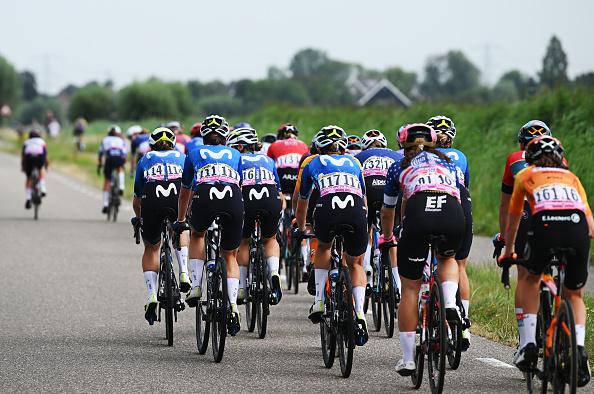Introduction
In the high-octane world of professional cycling, where endurance and peak performance reign supreme, female athletes face unique challenges that often extend beyond the physical demands of the sport. For many women cyclists, the monthly cycle presents an additional layer of complexity, as they navigate the dual pressures of training and competition while managing their menstrual periods. Despite advancements in sports science and growing awareness around female athletes’ needs, the intersection of menstruation and high-level competition can still resemble a labyrinth. This article explores how female professional cyclists confront these challenges, sharing insights from athletes and experts on the strategies they employ to maintain peak performance during their menstrual cycles and the ongoing efforts to destigmatize this natural aspect of their lives. As the cycling community continues to adapt and evolve, understanding the realities of menstruation is becoming essential in promoting not only equity in sports but also the overall well-being of female athletes.
Navigating Biological Cycles in Competitive Cycling
For female professional cyclists, navigating their biological cycles while competing can often feel like a perplexing challenge. Factors such as hormonal fluctuations can significantly impact performance, affecting everything from energy levels to mood. Many athletes report variations in endurance and strength throughout their cycle, leading to the need for tailored training regimens. To adapt to these shifts, athletes sometimes rely on personal tracking methods and data analysis to optimize performance, helping them know the best times for peak training and crucial races.
Moreover, support from coaches and teams plays a vital role in managing these challenges. Open communication about menstrual health is increasingly encouraged, allowing athletes to tailor their strategies and avoid performance dips. Some practices include:
- Menstrual Tracking Apps: Athletes utilize technology to predict key performance windows.
- Nutrition Adjustments: Dietary changes can help mitigate bloating and fatigue.
- Mental Strategies: Mindfulness and relaxation techniques are adopted for emotional regulation.
| Cycle Phase | Effects on Performance |
|---|---|
| Follicular Phase | Increased energy and strength |
| Ovulation | Peak strength and endurance |
| Luteal Phase | Potential fatigue and mood swings |
Strategies for Managing Menstrual Health on the Road
For female professional cyclists, balancing training regimes with menstrual health on the road requires thorough preparation and adaptability. Planning is essential; athletes often keep meticulous track of their cycles using apps or journals, allowing them to anticipate their periods and manage them effectively. This foresight enables cyclists to schedule training sessions around their cycles, optimizing performance during peak times. Additionally, maintaining a travel kit stocked with menstrual products – including organic or eco-friendly options, pain relief medication, and soothing essentials – helps alleviate discomfort and anxiety while racing or touring.
Dietary adjustments can also play a crucial role in supporting menstrual health. Many riders incorporate foods rich in iron, fiber, and omega-3 fatty acids to mitigate symptoms and maintain energy levels. Staying hydrated is equally important; electrolyte drinks can help counteract the fluid imbalance often experienced during menstruation. Here’s a quick overview of strategies cyclists often adopt:
| Strategy | Description |
|---|---|
| Cycle Tracking | Using apps or journals to record menstrual cycles. |
| Travel Kits | Preparation with menstrual products and health essentials. |
| Dietary Adjustments | Incorporating nutrient-dense foods to support overall health. |
| Hydration | Staying hydrated, especially with electrolyte-rich drinks. |
The Importance of Open Dialogue and Support in Female Cycling Teams
The experience of professional female cyclists is often enriched by open dialogue and supportive environments within their teams. Many athletes have found that discussing issues related to menstruation openly allows for a greater sense of camaraderie and understanding. By fostering a culture where female cyclists can express their concerns, teams not only enhance individual well-being but also contribute to overall performance. In addition to personal anecdotes, athletes can share strategies that help them manage their periods during training and competition, including:
- Flexible training schedules
- Access to menstrual health resources
- Peer support networks
- Nutrition adjustments
The implementation of team workshops and educational sessions can further empower cyclists to confront these challenges collaboratively. Encouraging discussion about menstruation not only normalizes the topic but also dismantles the stigmas surrounding it. Establishing an open support system can lead to a more cohesive and understanding team dynamic. Here’s a glimpse of how teams might prioritize menstrual health:
| Support Strategy | Benefits |
|---|---|
| Regular check-ins | Allows athletes to report discomfort without fear |
| Customizable gear options | Improves comfort and performance |
| Access to health professionals | Provides expert advice on menstrual health |
| Group discussions | Fosters community and shared experiences |
Insights and Conclusions
In conclusion, the journey of female professional cyclists navigating the complexities of menstrual health is a testament to their resilience and adaptability. As they face the demanding nature of their sport, these athletes continue to advocate for better understanding and support regarding menstrual issues. By sharing their experiences and strategies, they not only empower themselves but also pave the way for future generations of women in cycling. As the conversation around menstruation in sports evolves, it becomes increasingly clear that addressing these challenges is not just essential for individual performance but also a crucial step toward fostering a more inclusive and supportive environment for all female athletes. As they steer through this intricate maze, their determination continues to break barriers, inspiring both change and progress in the world of sport.











